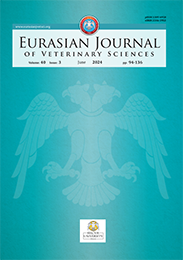| 2020, Volume 36, Number 4, Page(s) 340-346 |
| [ Summary (Turkish) ] [ PDF ] [ Similar Articles ] |
| Photographic capture-recapture modeling for estimation stray animal population: A pilot study |
| Doğukan Özen1, Erman Gülendağ1, Hülya Özen2 |
| 1Ankara Üniversitesi Veteriner Fakültesi Biyoistatistik Anabilim Dalı, Dışkapı, Ankara, Türkiye 2Eskişehir Osmangazi Üniversitesi Tıp Fakültesi Biyoistatistik Anabilim Dalı, Eskişehir, Türkiye |
| Keywords: Capture-recapture, stray dog, stray cat, Schumacher-Eschmeyer method, population estimation |
| Downloaded:716 - Viewed: 2342 |
|
Aim: Capture and recapture is a commonly used method to estimate an animal population's
size. The main purpose of this study was to introduce the Schumacher-Eschmeyer
method, one of the capture and recapture methods which is used to determine
the size of a closed population, with an application in a pilot area.
Materials and Methods: A predetermined route was used to collect data at Campus of Ankara University, Faculty of Veterinary Medicine and animals were counted at five different visiting times. Photos of animals were taken for marking purposes in each visiting time and archived. The data about total captured animals, animals of which recaptured and unmarked animals were collected for each visiting times. Obtained data was calculated using Schumacher-Eschmeyer calculation index. Results: In the study, a total of 50 cats and 49 dogs were recorded on the route, which was observed for 5 days. As a result of each sampling period, the stray cat population in the campus was estimated as 41 (95% CI: 34-52) and the stray dog population as 28 (95% CI: 24-34) using the Schumacher-Eschmeyer method. Conclusion: The Schumacher-Eschmeyer model stands out as a practical method that can be used in the estimation of unknown populations when appropriate marking methods are used, the closed population assumption is provided and when more than two counts are performed. |
| [ Summary (Turkish) ] [ PDF ] [ Similar Articles ] |





